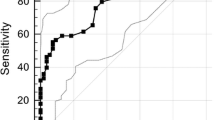Abstract
The purpose of this study was to test the reliability and validity of the Turkish Eating Assessment Tool (T-EAT-10) among patients with swallowing disorders. One hundred and five patients completed the T-EAT-10 and Functional Oral Intake Scale (FOIS). The internal consistency, test–retest reliability, and criterion validity of T-EAT-10 were investigated. The internal consistency was assessed using Cronbach’s alpha. Intraclass correlation coefficient (ICC) value with 95 % confidence intervals was calculated for test–retest reliability. The criterion validity of the T-EAT-10 was determined by assessing the correlation between T-EAT-10 and FOIS. All the patients in the study completed the T-EAT-10 without assistance. The mean time to complete the instrument was 1.8 ± 0.9 min. The internal consistency of the T-EAT-10 was found to be high with 0.90 Cronbach’s alpha for test and 0.91 Cronbach’s alpha for retest reproducibility. No difference between the test and retest scores of the T-EAT-10 was found (p = 0.14). A negative, moderate correlation between T-EAT-10 and FOIS was detected (r = −0.365, p < 0.001). The T-EAT-10 is a reliable and valid symptom-specific outcome tool for dysphagia in adult Turkish patients. It can be used in clinical practice and research.
Similar content being viewed by others
References
Farri A, Accornero A, Burdese C. Social importance of dysphagia: its impact on diagnosis and therapy. Acta Otorhinolaryngol Ital. 2007;27:83–6. doi:10.1007/s00455-001-0113-5.
Plowman EK, Tabor LC, Robison R, et al. Discriminant ability of the Eating Assessment Tool-10 to detect aspiration in individuals with amyotrophic lateral sclerosis. Neurogastroenterol Motil. 2016;28:85–90. doi:10.1111/nmo.12700.
Rofes L, Arreola V, Mukherjee R, Clave P. Sensitivity and specificity of the Eating Assessment Tool and the volume-viscosity swallow test for clinical evaluation of oropharyngeal dysphagia. Neurogastroenterol Motil. 2014;26:1256–65. doi:10.1111/nmo.12382.
Cheney DM, Siddiqui MT, Litts JK, Kuhn MA, Belafsky PC. The ability of the 10-Item Eating Assessment tool (EAT-10) to predict aspiration risk in persons with dysphagia. Ann Otol Rhinol Laryngol. 2015;124:351–4. doi:10.1177/0003489414558107.
Schindler A, Mozzanica F, Monzani A, Ceriani E, Atac M, Jukic-Peladic N, Venturini C, Orlandoni P. Reliability and validity of the Italian Eating Assessment Tool. Ann Otol Rhinol Laryngol. 2013;122(11):717–24. doi:10.1177/000348941312201109.
Burgos R, Sarto B, Segurola H, et al. Translation and validation of the Spanish version of the EAT-10 (Eating Assessment Tool-10) for the screening of dysphagia. Nutr Hosp. 2012;27:2048–54. doi:10.3305/nh.2012.27.6.6100.
Wakabayashi H, Kayashita J. Translation, reliability and validity of the Japanese version of the 10-item Eating Assessment Tool (EAT-10) for the screening of dysphagia. JJSPEN. 2014;29:871–6. doi:10.11244/jjspen.29.871.
Gonçalves MIR, Remaili CB, Behlau M. Cross-cultural adaptation of the Brazilian version of the Eating Assessment Tool - EAT-10. Codas. 2013;25:601–4. doi:10.1590/S2317-17822013.05000012.
Tombaugh TN, McIntyre NJ. The mini-mental State Examination: A comprehensive review. JAGS. 1992;40:922–35. doi:10.1111/j.1532-5415.1992.tb01992.x.
Crary MA, Mann GD, Groger ME. Initial psychometric assessment of a functional oral intake scale for dysphagia in stroke patients. Arch Phys Med Rehabil. 2005;86:1516–20. doi:10.1016/j.apmr.2004.11.049.
George D, Mallery P. SPSS for Windows step by step: A simple guide and reference. 4th ed. Boston: Allyn & Bacon; 2003.
Mukaka MM. Statistics corner: a guide to appropriate use of correlation coefficient in medical research. Malawi Med J. 2012;24:69–71.
Belafsky PC, Mouadeb DA, Rees CJ, et al. Validity and reliability of the Eating Assessment Tool (EAT-10). Ann Otol Rhinol Laryngol. 2008;117:919–24. doi:10.1177/000348940811701210.
Kaspar K, Ekberg O. Identifying vulnerable patients: role of the EAT-10 and the multidisciplinary team for early intervention and comprehensive dysphagia care. Nestle Nutr Inst Workshop Ser. 2012;72:19–31. doi:10.1159/000339977.
Acknowledgments
We would like to thank the patients who participated and consented to join this study.
Funding
The authors declared that this study has received no financial support.
Author information
Authors and Affiliations
Corresponding author
Ethics declarations
Conflict of Interest
The authors declare that they have no conflict of interest.
Rights and permissions
About this article
Cite this article
Demir, N., Serel Arslan, S., İnal, Ö. et al. Reliability and Validity of the Turkish Eating Assessment Tool (T-EAT-10). Dysphagia 31, 644–649 (2016). https://doi.org/10.1007/s00455-016-9723-9
Received:
Accepted:
Published:
Issue Date:
DOI: https://doi.org/10.1007/s00455-016-9723-9



